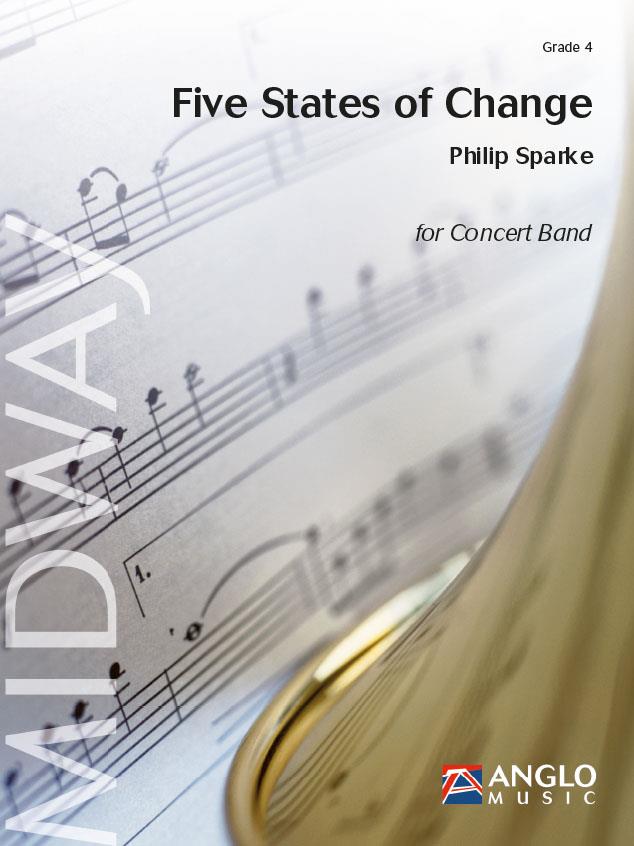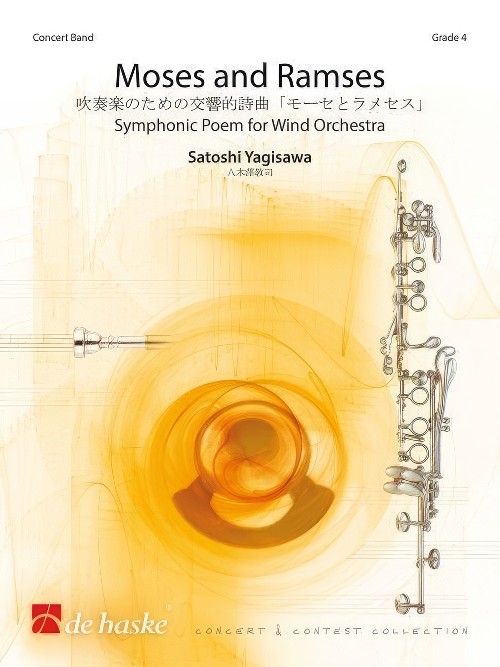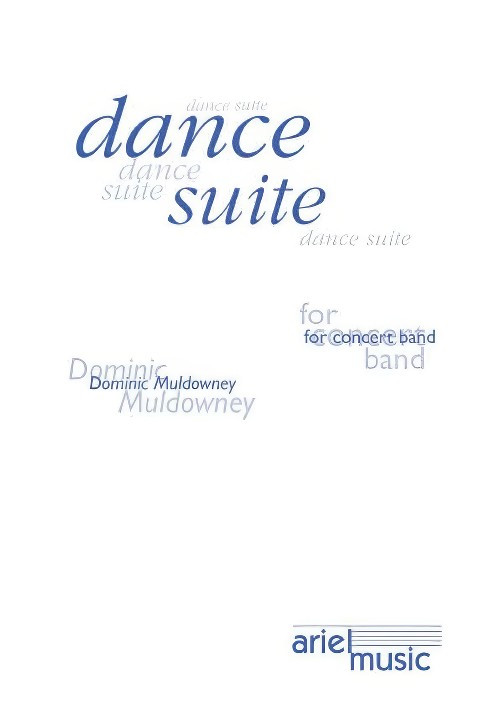Results
-
 £183.99
£183.99Five States of Change (Concert Band - Score and Parts) - Sparke, Philip
Five States of Change was commissioned by Kunstfactor for the 4th section of the Dutch National Brass Band Championships (NBK) 2011. It is dedicated to Jappie Dijkstra and the Music Information Centre (MUI), Arnhem, Holland, in acknowledgement of their outstanding work in developing band repertoire.The composer writes:The idea for the piece came when I was reading an article about a branch of Chinese philosophy which is abbreviated as Wu Xing*, which has no exact translation but can mean, for example, five elements, five phases or five states of change. It is central to all elements of Chinese thought, including science, philosophy, medicine and astrology, and in simple terms tries to create various cyclic relationships between five elements in all walks of life. An example is: Earth - Metal - Water - Wood - Fire - (Earth) etc. where (in one cycle) earth bears metal, metal changes to liquid (water) when heated, water helps trees grow, wood burns to create fire, fire produces ash (earth) and the cycle continues. I was particularly interested in the cycle of emotions:- Meditation - Sorrow - Fear - Anger - Joy - (Meditation) etc. and thought this cyclic principle would provide an effective emotional journey for a piece of music. So Five States of Change has five equal sections which loosely characterise this emotional cycle. I have tried to make the music grow organically, with minimal repetition, and each movement evolves from the musical elements at the end of the previous one, with the opening material appearing, transformed, at the end of the piece to complete the cycle.*in full Wu zhong liu xing zhi chi or the five types of chi dominating at different times.- Philip SparkeDuration: 12:15
Estimated dispatch 7-14 working days
-
 £149.99
£149.99Moses and Ramses (Concert Band - Score and Parts) - Yagisawa, Satoshi
This piece was commissioned by Matsudo Citizen Wind Orchestra for their 30th anniversary concert and premiered by the band conducted by Kenichiro Hasunuma in July 2009. This piece is typical of Satoshi Yagisawa in that it depicts a magnificent spectacle. This one is set in ancient Egypt and is based on the story depicted in the famous film "The Ten Commandments" (1956, directed by Cecil B. DeMille). One day Moses, who was raised by the rich royal family, found out that he was originally Hebrew. The Hebrews had been forced to live as slaves. Ramses, the prince directly descended from the Pharaoh, envied Moses' strength and popularity. After internal argument Moses decides to deliver the Hebrew from the Pharaoh's tyranny and escape from Egypt with them.The music starts with brilliant royal fanfare and depicts magnificent architecture, the Hebrew people forced into hard labour, and the slaves escaping from the Pharaoh's tyranny. At the climax they are at crisis point, trapped by the sea. Moses waves his staff and the miracle happens; the sea parts and Hebrew people successfully escape. Following on from Perseus - A Hero's Quest in the Heavens, this work Moses and Ramses is another piece written in the dramatic style favoured by Satoshi Yagisawa.Duration: 9:30
Estimated dispatch 7-14 working days
-
Forgotten Children - Peter Meechan
Forgotten Children is a short work for wind orchestra and electronic accompaniment. Adapted from it's original form (for brass quartet and CD, Forgotten Children was written for The Desert Winds and their conductor Chuck Maguire, to whom the piece is dedicated.Whilst conceiving the piece, the subject of the war in Syria dominated news headlines, specifically the refusal by Western nations to intervene. There were, of course, political reasons at the heart of the decision, complicated by a situation that no one understood in a country no one understands. The harrowing images of chemical weapons being used on children was seemingly not enough to persuade the West that their help was needed, but those silent voices fell on even deafer ears. They were, and still are, the Forgotten Children.Please download the electronic accompaniment below.
Estimated dispatch 5-14 working days
-
 £66.95
£66.95Quest of the Magi - Brian Beck
The Quest of the Magi was one of the working titles for John Henry Hopkins Jr.'s famous carol, "We Three Kings." Written in 1857 for a Christmas pageant in New York City, "We Three Kings" tells the tale of the Magis' journey to find a newly born king in a faraway land and the precious gifts they brought with them. This piece focuses more on the journey of "following yonder star." Traveling across many countries in the first century was a perilous task, full of danger, thievery, and possible death, not to mention these men were traveling with some of the most precious and expensive cargo one could possess. This piece chronicles the magi acquiring myrrh, frankincense, and gold for their journey. Each treasure is represented by its own motif and woven into Hopkins' original carol. (2:45)
Estimated dispatch 7-14 working days
-
£69.99
An Irish Lullaby - Stephen Bulla
What can be more charming than a comely Irish folk melody? This is music that allows the band to play in the rubato style, with much room for expression. Found in an old British publication and simply called "Irish Air," this endearing arrangement is a rhapsodic treatment that takes fragments of the melody and develops them into a large symphonic work. The freedom of tempi allows you to work with your band in a sensitively conducted way that only a beautiful piece like this will allow.There is always room on a concert program for at least one lush, melodic contrast piece. Perhaps this one is for you. It's so difficult to describe a thing of real beauty. Please listen tothe demo recording and hear it for yourself.
Estimated dispatch 7-14 working days
-
 £137.99
£137.99Odyssee - Jan Bosveld
The Odyssee tells the story of Odysseus, the undaunted hero. In times long ago the blind poet Homer wrote this famous epic. The "Odyssey" follows the "Iliad", the story of the bloody war between the Greek and the Trojans. This battle endsafter ten years thanks to the Odysseys famous trick. the Trojan Horse. The Odyssey is not a war epic, but a story about perseverance, loyalty, adventure, and the survival instinct of its ingenious hero. In The Odyssey, Homer describes howOdysseus, the king of Ithaca, had to endure another ten years of affliction after the ten years of war in Troy before he could finally return to his home land. During those years, his wife, Penelope, had to try and keep her many admirers away.These men not only wanted het hand but also the kingship. To prove her husbands worth, she played a trick: "As soon as I have finished weaving this shroud for my father-in-law, Laertes, I will choose one of you to become my husband", she promisedthem. But during the night, she secretly loosened what she had woven during the day, prolonging the time until Odysseus would finally return. After twenty long years, when he finally stood at the door, she wondered: Is this really my husband? Ishe an imposter? Cunningly, she asked him to move the bed, because only she and her husband know that the bed was immovable and was build around an old three trunk! Odysseus was deeply moved: this really was his wife, his Penelope! Nearly threethousands years later, the loyalty and strength of this character, and all the dangerous adventures that Odysseus survived thanks to courage and intelligence, still moves us today. Odyssee by Jan Bosveld is not just an adventure story, butrather a characteristic piece in which memories of Homers story can be heard. The composition opens with a firm, stirring theme describing our hero, Odysseus, in detail: This man is not to be taken lightly. The further development of thisshort introduction completes this character sketch: trustworthy, perseverant, and a genius. After that we can picture Odysseus on the lonely beach of Ogygia. Do the trumpets depict his memories of the war of Troy? Does he think of his wife, as werecognise the weaving loom of Penelope in the murmuring eighth? In the solemn, plaintive part that follows, we can imagine Penelope feeling lonely, sitting in the womens room with her servants.One of the girls plays the harp, but that does notclear the sombre atmosphere. Then we can imagine seeing the sorceress Circe, who changed Odysseus men into swine. After she gives a simple magic sign something follows that reminds us of the sound of pigs grunting. Then the Odysseus theme resounds:the hero comes to savi his comrades. Assisted by Hermes, he forces Circe to lift the spell. The piece ends the same way as it began, with an animated theme: Odysseus is still the same, undefeated and not to be taken lighty!
Estimated dispatch 7-14 working days
-
 £110.00
£110.00Mount Everest - Kees Vlak
This composition basically consists of three fragments and an epilogue (conclusion):1) Plateaux, 2) Sherpas, 3) Climb. The piece starts with a musical depiction of the deserted plateauxs and mountain peaks of the Himalayas. The mysteriousness of theTibetan country was caused by its inaccessibility to other nations. One even believed that there was a paradise behind the huge mountains; the land of Shangra La. 1) After the sound of a gong, the Asian-like theme arises extremely softly from thedecay of the percussion. In bars 4 and 5 the syllables of Hi-ma-la-ya echo. Then a second theme appears; it symbolises the enchantment of the mountaineers by seeing the Mount Everest. 2) Eastern percussion, very evenly without emotion, sound from thedeserted village of the sherpas. The phrasing is prescribed by the number 'three'. From measure 56 Tibetian monks sing a chant, also with the religious background of the number 'three'. 3) The third part starts of with the sight of the giant MountEverest with an entirely new theme, that is played impressively by the strong low brass instruments of the band, immediately followed by the excited big climbing. The many surprises are depicted by the changing time signatures. Two themes are inconstant battle; the binary Himalaya theme and the ternary Mount Everest theme. Only once there is a steely composure. The registers in which the piece is played increase. The tension rises...Then the peak is reached. A long pause follows before onerealises that one is on top of the world. Slowly the emotions of joy grow and lead to an enormous climax. The first enchanted theme sounds again in total glory.
Estimated dispatch 7-14 working days
-
£52.50
No Stop Rock - Carmine Pastore
A Grade 1 rock anthem! It's a perfect way to keep your beginners motivated while you drill them on that new concept called "eighth notes." Lots of repetition of simple eighth note figures will help your young band players enter the fascinating world of the divided beat with ease.This solid minor key rock-type piece will also help to keep your audience attentive by letting them hear a bit of a style they are so accustomed to. The overwhelming rhythmic nature of the piece also makes it a possible choice for use with an elementary level massed band. When faced with more than 100 beginners at a time, one likes to do music that has a beat they can hang on to! Whether it's for asmall one-school band or a giant massed group, this one is sure to work for you.
Estimated dispatch 7-14 working days
-
 £54.99
£54.99Concerto for Triangle - Mike Hannickel
This easy-to-prepare beginning band comedy piece will have the audience rolling in the aisles. Feature that popular principal, custodian, secretary or any other staff or community member who has a little bit of comedian in them as the "Triangle soloist." One interruption after another prevents the "soloist" from actually playing the Triangle until the very end of the piece where, with a band member's assistance, the soloist finally gets to play the Triangle one single time. Everyone will love it! Side-splitting!
Estimated dispatch 7-14 working days
-
 £160.00
£160.00DANCE SUITE (Concert Band) - Muldowney, Dominic
Includes:1. Hey2. Pavane/Waltz3. Polka4. Waltz/Galliard5. Tangos6. Break-DanceDance Suite displays a variety of historical dance forms from a twentieth century viewpoint. The six dances move forward historically from the ancient Hey, through Waltz and Polka, to the sophisticated Tango and the jazz tradition. The rhythm that typifies each dance is constantly under attack, sometimes from a different dance style altogether. These intrusive elements are most obvious in the final dance and prompts the double meaning of the title.I. HEYHey is constructed like a mediaeval motet, where the main blocks of material are rhythmically unconnected to one another. The percussion is the most disconnected of all and seems to have arrived from a Chinese carnival. The scoring alludes to the eight, four and two foot pipes of a baroque organ.I. PAVANE/WALTZAfter a nod in the direction of Dowland's Lachrimae Pavan, the piece seems to wander to and fro between the 16th century and the 19th century world of the Lehr waltz.I. POLKAThe Polka is derived from a four bar fragment found in Stravinsky's sketchbook for The Rite of Spring above which is written: "Dieppe Polka".I. WALTZ/GALLIARDThis is a reversal of the date-shift process in the second movement, in that the wandering goes backwards rather than forwards, particularly to the William Byrd of the Fitzwilliam Virginal Book.I. TANGOSA slow sentimental tango is sandwiched between an abstract deconstructed one, both of which are developed in Dominic Muldowney's opera The Voluptuous Tango.I. BREAK-DANCEBreak-Dance is the fastest, hardest and strangest movement. Its exuberance fractures the texture, which slowly crumbles midway through the movement, only to be resurrected mirror fashion. The piece is a species of palindrome with no true centre, hence: "Break-Dance".Conductors are free to make a selection from these dances for festival or competition programmes, when limited performance time is available.
Estimated dispatch 7-14 working days
